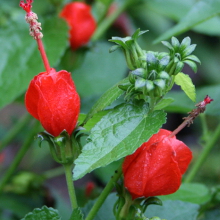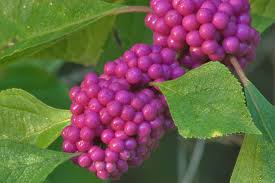Round Top’s Native Texas Plants

2025 Spring Antiques Show | March 20 – April 6
2025 Fall Antiques Show | October 4 – 18

by Calvin R. Finch, PhD
Horticulturist and Director
Texas A&M Water Conservation and Technology Center
The Round Top area has a large palette of native Texas plants that prosper in its soil and weather conditions. Here is a list of native plants to consider that will provide your landscape twelve months of color. These natives evolved in the area and are well-suited to its growing conditions including periodic droughts.

January
In January, rely on two berry producers—possumhaw holly and beauty berry—for color. Birds will eat the berries sometime in late winter, but until then the plants are very decorative. Possumhaw has a horizontal growth pattern with small red berries arranged along the stems. Beauty berry has a weeping growth form with purple berries hanging on the branches.
February
In February, Texas redbud is covered with pink blooms. Plant it under large shade trees at the landscape’s edge. Small redbud trees seem to disappear after they bloom, but the color is welcome in February. As a second choice for the month, Carolina jessamine is an evergreen vine that produces fragrant yellow blooms. It also has some shade tolerance.
March
March is the month when some of our most distinctive native plants contribute color. Cross vine is an evergreen that is covered by rust-colored blooms throughout the year, but the real show is in March. For a tangerine-colored cross vine, plant the selection, “Tangerine Beauty.” Texas mountain laurel is everyone’s favorite evergreen native shrub. Its purple blooms perfume the air with grape Kool-Aid fragrance in March.
April
April native color is provided by Mexican olive and cherry sage. The white-flowered Mexican olive is not related to the olives we eat. It forms a small (15 ft.) evergreen tree that is covered with blooms over a long season. Cherry sage is also called autumn sage or Salvia greggii. It is a shrub available with red, white, pink or salmon blooms that are showy both in the spring and fall. It’s a favorite hummingbird plant that is not eaten by deer.

May
For May color consider Turk’s cap. It grows well in the shade with three-inch heart-shaped leaves and small red blooms. It’s another hummingbird favorite.
June
In June think about cenizo, which requires full sun to bloom. It’s a shrub that will grow to eight feet tall and can even be pruned to a hedge. It’s a distinctive landscape plant with silver leaves and lavender-blue blooms that cover the plant after it rains. Deer don’t eat cenizo.
July
July is often our hottest month, but the heat doesn’t phase two heavily blooming native plants—sunflower and “Gold Star” esperanza—that prefer full sun. There are several varieties of sunflowers to grow from seed. Maximilian sunflower naturalizes and reappears to produce color and seeds for the birds every year. “Gold Star” esperanza is also called Texas bells. It’s a deer-proof shrub that freezes back to the roots each year after providing yellow blooms on the hottest, driest and sunniest sites all summer.
August
In August use red yucca for native plant color. The red blooms on six-foot tall stalks are showy and attract hummingbirds.
September
A good native color plant for September is purple cone flower, a reseeding perennial included in many wildflower seed mixes. The low clumps of foliage produce sunflower-like blooms with lavender petals.
[pullquote width=”300″ float=”left”]”The Round Top area has a large palette of plants that prosper in its soil and weather conditions.These natives evolved in the area and are well-suited to its growing conditions including periodic droughts.”[/pullquote]
October
In October, Mexican bush sage produces blue blooms on stalks above the foliage. Deer don’t eat the plants, but they are a favorite hummingbird nectar source.
November
Native plants selected for color in November only bloom for a short period, but they become the center of attention then. Fall aster forms a mound six feet wide and three feet high that becomes covered with blue blooms. Grow fall aster in full sun. The appearance is spectacular, and it is a favorite butterfly plant. Mint marigold spreads out like fall aster and is nearly as showy but with golden, anise-scented blooms that steal the show after fall aster. Deer don’t eat mint marigold.

December
To finish out the year of native color, plant a set of five – seven gulf muhly grass clumps. The seed heads are pink-colored above the gray green foliage. Seed-eating birds, such as goldfinches and buntings, eventually eat the seeds but not until the colorful seed heads have decorated your landscape for most of the winter.
For more details on these plants, visit plantanswers.com.
2025 Spring Antiques Show | March 20 – April 6
2025 Fall Antiques Show | October 4 – 18